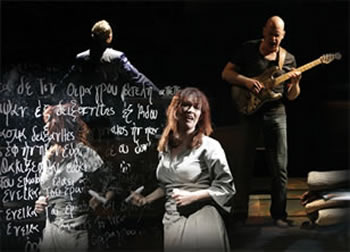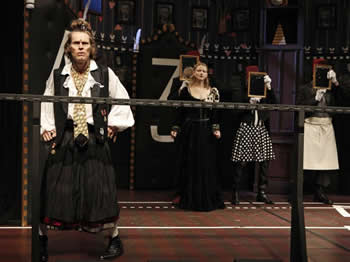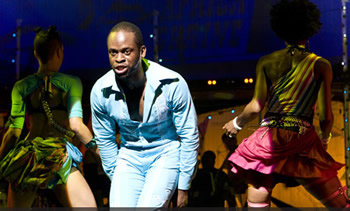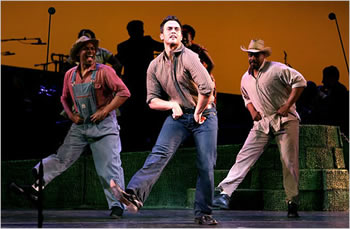HotReview.org Editor's
Picks
Shows Worth Seeing:

Orpheus X
By Rinde Eckert
The Duke on 42nd St.
229 W. 42nd St.
Box office: (646) 223-3010
The mythical Orpheus was undone by a moment
of desperate doubt. A musician so skilled he could move rocks
and trees with his lyre, he convinced the rulers of the underworld
to release his beloved Eurydice but lost her again by looking
over his shoulder. In Orpheus X, the writer, composer
and performer Rinde Eckert (whose musicalized Moby Dick
adaptation in 2000, And God Created Great Whales, was
extraordinary) reimagines this heartbreaking tale as a mini-opera
about the obsessions and chronic self-doubts of a famous rock
star. The meteoric career of Eckert’s Orpheus comes to a
standstill after a taxi he is riding in accidentally kills a beautiful
poet named Eurydice. He then reads her poetry and comes to know
and envy her as an artist courageous enough to face questions
of emptiness he had always avoided. Meanwhile, Eurydice adjusts
to the underworld, where all writing is done in chalk, easing
the process of forgetting. What is the meaning of a rescue attempt
in this circumstance? What good, and whose interest, does it serve?
In this piece, Eckert has graduated from the quiet duo cast with
piano in And God Created Great Whales to a trio cast
with a crackling four-piece jazz-rock band. He performs here with
the marvelous singers Suzan Hanson and John Kelly. Directed by
Robert Woodruff, he has also incorporated video, collaborating
with videographer Denise Marika and set designer David Zinn to
create a fantastically spooky and resonant environment that never
lets the eye rest. This is a place where coming to terms with
mortality and finding enduring reasons to make art seem self-evidently
like twin obsessions--two sides of the same creative coin. The
show is also unforgettably sensuous (Hanson, for instance, furiously
writes on the floor with chalk, in the nude, beneath the bleachers
as the audience enters). It's also powerfully haunting, not least
because the music alternates between heartbreakingly simple melody
and grating dissonance.
--------------------------------------

Idiot Savant
By Richard Foreman
The Public Theater
425 Lafayette St.
Box office: (212) 539-8500
For several years Richard Foreman has been
trying to incorporate film and video into his theater works, with
rather spotty and frustrating results. The biggest problem, in
my view, has been that while his theater always drew its life-breath
from an intense engagement with present-tense moments, perpetually
refreshed and reinvigorated by his fragmented texts and enigmatic
staging techniques, film and video could never replicate that
experience because they were always showing past events. The superimposed
media passages could never be risky or unpredictable like the
live theatrical action; worse yet, they were inherently competitive
with it. They had the effect of draining energy from the live
action, making it seem slow and anemic, and one left the productions
wondering why Foreman didn’t just make a film.
In his latest work Idiot
Savant, he has wisely returned to his core strength: theater
that trades on the perpetual surprise of each and every newly
arriving moment. The show’s text is ostentatiously resistant
to story and character development, as always. The stage is outfitted,
as usual, as a cluttered art installation, with Hebrew letters,
strings, and fetishized bric-a-brac everywhere. What’s new
this time is a certain air of compromise with conventional theater
in that the actors now often do what they say: e.g. hold out a
gift-wrapped box when referring to one, or attempt to kiss when
speaking of kissing. This literalism makes the action seem more
accessible even when it isn’t. The show’s pace is
also slower and more deliberate than in the past, as if Foreman
had made a pointed effort to meet his larger audience in the middle
(the show is performed at the Public rather than at Foreman’s
own tiny space), only to demonstrate that this middle is every
bit as bewildering as the extremes they may have feared. There
is a certain confident savoir faire in the air here, emanating
no doubt partly from the star actor in the leading role: Willem
Dafoe.
Foreman’s recorded
voice warns the performers near the beginning that they shouldn’t
try to steer the action toward any particular purpose but rather
allow it to remain a series of obscure and ambiguously related
moments. Dafoe enacts the central consciousness charged with upholding
this doctrine of resistance to Aristotelian drama—a role
(if we can call it that) that he plays with marvelous, nonplussed
savoir-faire. Foreman teases him (and us) with various allurements
from the dramatic model we supposedly hunger for, such as a sudden
desire at one point to appear not in Idiot Savant but
rather in a different play called Arrogant Fool (presumably
akin to Oedipus Rex), but he bumbles on to fulfill his
Foremanian anti-destiny with Mister Magoo aplomb. The etymological
root of the word “idiot” is the Greek “idiotes,”
meaning a private person lacking particular skills and hence any
meaningful relationship to the social group. Foreman’s “idiot”
refuses what is the traditional lead actor’s relationship
to his public, based on ingratiation and servility, offering instead
a reinvigorated concept of the social group based on our mutual
enjoyment of present-tense moments. In such a utopian world, everyone
is a “savant.”
---------------------------------

Fela!
By Jim Lewis and Bill T. Jones
Eugene O'Neill Theater
230 W. 49th St.
Box office: (212) 239-6200
Before Fela!, Bill
T. Jones’ and Jim Lewis’ musical about the career
of the Nigerian song-writer and performer Fela Anikulapo-Kuti
(1938-1997), my high standard for sheer dancing energy in a Broadway
show was In the Heights, Lin-Manuel Miranda’s salsa-packed
musical-explosion about love and loyalty in an unsung Manhattan
neighborhood. Astonishing as it may be, the first hour of Fela!
is actually more percussion-pumped and ice-water-in-the-face bracing
than Miranda’s show. It also tries to evoke a very specific
place. Fela!’s producers have decorated the interior
of the Eugene O’Neill Theatre like the Shrine nightclub
in Lagos where Fela made musical and political history by developing
a form of rebellious music known as Afrobeat, combining his songs
with seditious talk from the stage, and refusing to leave the
country even when threatened, arrested and beaten by the authorities.
There are works of African art, political posters and news clips
from the 1960s and 70s on nearly every surface, and some seats
have been removed to allow performers to dance and frolic in the
aisles.
In this happy and upbeat environment,
the show begins with an infectious, pelvic-gyrating number illustrating
the tremendous appeal and tenacious hold of Afrobeat, and it doesn’t
let up until intermission. The electric dynamism running through
the lead actor (I saw Kevin Mambo, who alternates with Sahr Ngaujah),
as well as the seductively undulating chorus of female dancers
and the crack jazz-rock band, makes the political threat that
this music posed to Nigeria’s dictatorial regime clear and
palpable. That is a remarkable achievement when you think it over:
Jones and Lewis have done (at least for an hour) what no rock
musical since the original Hair (NOT the recent revival)
has managed to do: communicate viscerally how music itself may
be truly political dangerous under certain social conditions.
The problem is that, after this dynamite opening, the show unfortunately
has nowhere to go. It can’t tell a sophisticated or complex
biographical story while keeping its music and dancers constantly
pumping, and the percussion alone isn’t enough to sustain
interest for 2 hours and 40 minutes. The show’s book, mostly
stuffed into extremely brief remarks between songs, soon gets
bogged down in very sketchy political slogans and romantic bromides,
and the evening seems to limp to a finish despite its non-stop
energy. The first half of Fela! is well worth it, however.
You’ll learn much that you didn’t know, and you won’t
soon forget those swinging pelvises.
------------------------------------

Finian's Rainbow
By Burton Lane, Yip harburg and Fred Saidy
The St. James Theatre
246 W. 44th St.
Box office: (212) 239-6200
Finian’s Rainbow is a charming,
feel-good artifact from 1947 that turns out to have a few pointed
political barbs for 2009. A fanciful, often preposterous tale
about people who bury leprechaun gold in the emblematic southern
state of Missitucky, it offers a loopy version of the same refreshingly
exuberant post-war optimism that made Oklahoma such a
landmark in musical history. The key difference between the two
shows is that Finian’s Rainbow confronts several
serious potential obstacles to the putative golden future of the
nation: namely, greed and racism. The Irish immigrant Finian brings
stolen leprechaun gold across the ocean because he’s convinced
that burying it near Fort Knox will make it grow. It doesn’t
literally grow, but it does instill hopefulness in the local populace—a
feeling that’s presented as a moral obligation. Interestingly,
one of the show’s key songs is about the virtue of buying
on credit. The audience laughs heartily at that, most of them
no doubt oblivious to the fact that the play is in part laughing
at them. The message, I suppose, is that people have to trust
one another; that’s what makes our country and our capitalist
system great. Yet it’s also made clear that the future is
only as secure as the next outsize order for the tobacco the sharecroppers
break their backs to harvest. In any case, the best humor in the
play isn’t about greed but rather intolerance. The satirical
sequence where a racist U.S. Senator is turned temporarily black
by leprechaun magic will never grow old. The play also quietly
mocks the no-brain optimism of the star couple’s happily-ever-after
marriage with a subplot marriage between a lonely mute girl and
a roving-eye leprechaun who admits he just wants to “love
the girl I’m near.” This revival directed and choreographed
by Warren Carlyle is solidly cast and infused with just the sort
of wit-inflected earnestness the material needs. (Any whiff of
South Park cynicism would kill it.) The producers also
deserve credit for recognizing the affinities of such old and
comparatively simple material with our complicated current moment.
